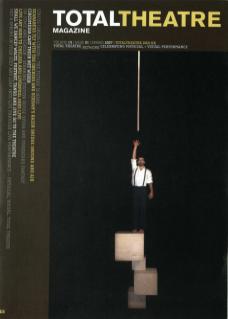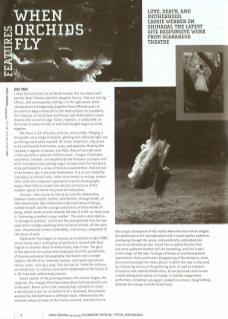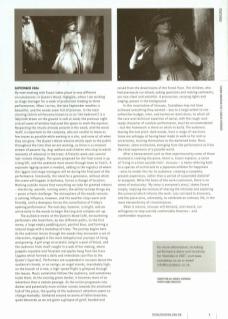July 2006
I meet Daniela Essart at the North London flat she shares with partner Søren Nielsen and their daughter Naissa. They are moving offices, and consequently nothing is in the right place, while collaborators are beginning to gather from different parts of the world to begin rehearsal for the latest project by Scarabeus, the company run by Nielsen and Essart, and dedicated to visual theatre with an aerial edge. Essart, however, is undaunted, as the result of many months of work and thought begins to come together.
The house is full of books, pictures, and orchids. Hanging in the garden are a range of objects, glinting with reflected light and sprinkling sound when touched. On closer inspection, they prove to be constructed from knives, woks, and spatulas. Made by the company’s regular composer, Jym Daly, they will provide some of the sound for a planned ‘kitchen scene’. Images of domestic naturalism, however, are dispelled by the fantastic concepts with which Scarabeus have already begun to experiment for this piece, to be performed in a series of forests around Britain. And not just in the forests, but in the trees themselves. It is an aim stated by Scarabeus to interact with, rather than merely to occupy, chosen sites, while the company’s experience in aerial choreography equips them fully to inhabit the natural architecture of the outdoor spaces in which this piece will take place.
Shimadai – When Orchids Fly has at its core the relationship between Essart and her mother, and the loss, through death, of that relationship. Also influential is the experience of being a mother herself, and the strange conjunction of these modes of being, which comes to pass towards the end of a life: as Essart puts it, ‘becoming a mother to your mother’. The work is described as ‘a homage to mothers’, and Essart has extrapolated from her own experience to begin exploring more universal themes. At the same time, the personal remains embedded, a necessary component of this piece of work.
Exploration first began on Shimadai at Circelation in April 2005, where Essart and a small group of performers worked with Rose English to examine ideas of motherhood, and of loss. The germ of the idea was for a piece that employed all of the possibilities of theatre and aerial choreography, but had at root a simple subject, the life of an ‘ordinary’ woman, with quiet aspirations: family, home, running a shop. One aim was to ‘make the ordinary extraordinary’; to create a work which celebrated all the facets of a life lived with understated passion.
Essart speaks of the grieving process; the various stages, the surprises, the changes that have come about both personally and in the work. Where at first the company had intended to create a spectacular event for an audience of a thousand, the creative process has led them down a different route. Influenced by the intimate nature of some of the stories involved, and sensitive to the unique atmosphere of the woods where the work will be staged, the performance will now take place with a much smaller audience, journeying through the space, and potentially subdivided into even more intimate groups. Essart has accepted the fact that not every audience member will see everything, and this is part of the magic of the idea. Footage of Research and Development experiments shows performers disappearing in the distance, clues discovered amongst the trees, places in which the view is obscured by intervening leaves or the gathering dark, as well as moments of surprise and intense theatricality. At one point we come across a meal taking place above our heads; in another image three performers, including a young girl, draped in crimson, hang halfway between the canopy and the forest floor.
September 2006
My next meeting with Essart takes place in very different circumstances: in Queen’s Wood, Highgate, where I am working as stage manager for a week of production leading to three performances. When I arrive, the late September weather is beautiful, and the woods seem full of promise. In the main clearing (which will become known to us as ‘the bedroom’) is a labyrinth drawn on the ground in salt or sand; the previous night a local coven of witches had used the space to mark the equinox. Respecting the rituals already present in the wood, and the wood itself, is important to the company, who are careful to leave as few traces as possible while working in a site, and none at all when they are gone. The Queen’s Wood remains wholly open to the public throughout the time that we are working, so there is a constant stream of passers-by, dog-walkers and children who stop to watch moments of rehearsal in the trees. A frenetic week sees several last-minute changes. The space proposed for the final scene is up a long hill, and the audience must weave through trees to find it. A separate rigging system is needed, adding to the logistics of where the riggers and stage managers will be during the final part of the performance. Eventually, the need for a generator, without which the scene will happen in darkness, forces a change of location. Working outside means that everything we take for granted indoors – electricity, warmth, running water, the ability to keep things dry – poses a fresh challenge. The atmosphere of the woods remains a calming influence, however, and the weather stays warm and friendly, until a downpour forces the cancellation of Friday’s opening performance. The next day, however, is bright, and we arrive early in the woods to begin the long and complex set-up.
The audience meets at the Queen’s Wood Café, encountering performers who lead them, by two different paths, to the first arena, a large empty paddling pool, painted blue, and forming a natural stage with a backdrop of trees. The journey begins here. As the audience moves through the woods they encounter a set of characters, engaged in the more metaphorical journeys of living and growing. A girl sings an ecstatic song in a pool of blood, and the audience finds itself caught in a web of her making, where puppets copulate and fairytale red apples hang from the trees (apples which formed a daily and immediate sacrifice to the Queen’s Squirrels). Performers are suspended in cocoons above the audience’s heads, or on swings; an angel stands, improbably high, on the branch of a tree; a high-speed flight is glimpsed through the leaves. Music sometimes follows the audience, and sometimes leads them. As the evening grows darker, it becomes more of an adventure than a sedate passage. As the action progresses into darker and potentially more sinister scenes towards the emotional hub of the piece, the quality of the audience’s attention seems to change markedly. Gathered around an arena of fallen branches, quiet descends as we are given a glimpse of grief, hooded and raised from the dead leaves of the forest floor. The children, who had previously run ahead, asking questions and making comments, are now silent and watchful. A procession, carrying lights and singing, passes in the background.
In this incarnation of Shimadai, Scarabeus may not have achieved everything they wanted – due to a large extent to not unfamiliar budget, time, and technical restrictions, to which all the care and technical expertise of aerial, with the rough-and-ready character of outdoor performance, must be accommodated – but the framework is there on which to build. The audience, leaving the now pitch-dark woods, have a range of reactions. Some are unhappy at having been made to walk so far and so uncertainly, trusting themselves to the darkened trees. Most, however, seem enchanted, emerging from the performance as from the total experience of a parallel world.
After a bereavement such as that experienced by some of those involved in creating the piece, there is, Essart explains, a sense of ‘living in a time outside time’. Shimadai – a name referring both to a species of orchid and to a Japanese emblem for happiness – aims to render this for its audience, creating a complete, present experience, rather than a period of suspended disbelief or escapism. While the basis of the work is personal, there is no sense of exclusivity: ‘My story is everyone’s story,’ states Essart simply, implying the mixture of sharing the intimate and exploring the universal which informs the work. Loss can lead to discovery, and the piece aims, ultimately, to celebrate an ordinary life, in the most extraordinary of circumstances.
When it returns, Shimadai will demand, and reward, our willingness to step outside comfortable theatres – and comfortable responses. For more information, including performance dates and locations for Shimadai in 2007, visit www. scarabeus.co.uk or email info@scarabeus.co.uk


